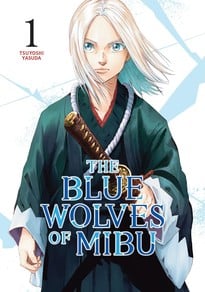Review
by Rebecca Silverman,The Blue Wolves of Mibu
Volume 1 Manga Review
| Synopsis: |  |
||
Japan, 1863. With the country's opening to foreign countries, differences abound as to whether or not this is a good thing or if the Shogunate should continue to be the ruling element. Into the fray steps a group of masterless samurai, based in the Kyoto suburb of Mibu. This group doesn't have a great reputation among the locals. Still, when young orphan Nio meets two of their number, Hijikata Toshizo and Okita Soji, he realizes there may be more to them than just their reputation. Nio joins the group, and the wheels of history begin to turn… The Blue Wolves of Mibu is translated by Stephen Paul and lettered by Phil Christie. |
|||
| Review: | |||
The Shinsen-gumi is pretty inescapable in Japanese fiction, and I fully admit that most of my reading about them in the manga and visual novel sphere has been on the shōjo side – the Hakuouki franchise and the incomparable Kaze Hikaru, in particular. But there's undoubtedly more than just those two, and all of them take a different approach to the subject matter, no matter who the intended audience is. The Blue Wolves of Mibu is a male-oriented approach. However, it still shares some similarities with its female-oriented counterparts, namely that the focus is on Hijikata, Okita, and a preternaturally beautiful insert character, a white-haired young teen named Nio. (Apparently, there's a rule that all author-created characters who join The Shinsen-gumi are beautiful and feminine in appearance, regardless of their gender.) It largely follows the tropes of the genre, with Nio encountering Hijikata and Okita, joining the group when they're still called the Miburoshi, and learning the true nature of this force behind the history. Nio is a relatively easy character to get behind. He's earnest and well-meaning, and he's also intellectually curious enough that he wants to understand where the gap is between the Miburoshi's reality and its reputation. His main drive is to secure the best possible future for Japan, inspired in large part by the kindness he's experienced. Orphaned at a young age, Nio was first raised at a temple and later adopted by an older woman, along with another child. Primarily raised by the woman in her restaurant, he's very aware of his unusual appearance and how good his adoptive grandmother and sister are to him despite that. When Hijikata and Okita witness his physical skills, they invite him to join Miburoshi, an invitation he accepts. He moves to the group's headquarters and meets other familiar names, such as Harada Sanosuke, Nagakura Shinpachi, and Isami Kondo. The focus of the volume is on introducing the characters and situation. It's framed as a tale told by an old man long after The Shinsen-gumi has met its end. The narrative purports to tell the story of members forgotten by history, although the fact that a fellow recruit is named "Hajime" may risk putting a bit of a lie to that, given that Saito Hajime hasn't shown up. It's mostly set up and perfectly fine - it doesn't do much different from other similar works, establishing the leading players, the way the group functions, and indulging in plenty of action scenes. These slot into three distinct categories: training, hijinks, and actual battles, with the middle getting the most page time. That's very likely in service of making sure that we understand the characters and their relationships; goofing around together is a shortcut to demonstrate the good-natured atmosphere within the group that contrasts both later actions taken by the characters and the Miburoshi's reputation within Kyoto and its environs. It also allows Nio to start thinking about who and what to believe, something we can see happening as he both participates and takes everything in at the slight removal of a newcomer to an established group. The art is reasonably comfortable with its setting, characters, and action scenes, with the only real issue being the art for the faces; they feel very overdrawn, to the point where they stand out uncomfortably from the rest of the artwork. That's not to say that the backgrounds and clothing (important markers of period setting) aren't detailed, but there's something much more organic about the way they're drawn. In contrast, faces mostly feel like the artist was trying a little too hard to make the protagonists stand out. Color art is much more palatable, and it's a shame that there isn't more of it. Overall, The Blue Wolves of Mibu's first volume is fine. That sounds like damning it with faint praise, but the reality is that in its opening, it isn't all that different from any other straight historical fiction manga about The Shinsen-gumi. That makes it a safe bet for fans of the subgenre, and I think it will begin to distinguish itself from other similar books quickly that the introduction is taken care of. But if you're not a Shinsengumi devotee, you'll want to flip through this before making a decision. |
| Grade: | |||
|
Overall : B-
Story : B-
Art : B-
+ Solid introduction with a nice framing device. |
|||
| discuss this in the forum | | |||
| Production Info: | ||
|
Full encyclopedia details about |
||